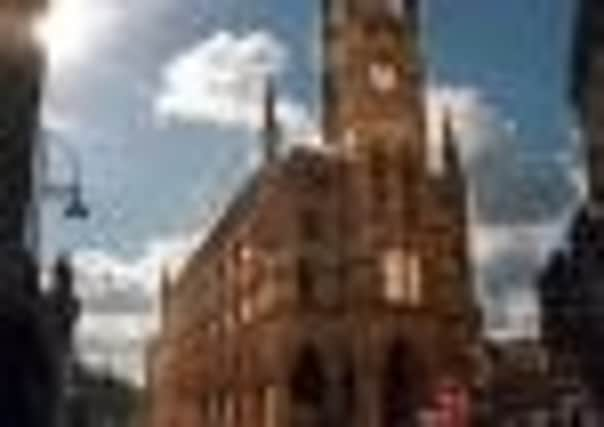Lost glory of Victoria halls


Temples were raised to Mammon as well as God, in praise of the prosperity that flowed from engineering or textiles, solid and sometimes flamboyant buildings that expressed confidence via stone, steel and glass.
In many cases, they defined the character and outlook of the towns and cities of the industrial West Riding, institutes, churches and arcades that represented hard work, piety and the rewards that came the way not so much of those who laboured in the mills and factories as those who owned them. Over time, they were to become landmarks, soot-blackened and seemingly immovable parts of the urban landscape, reminders – for those who cared to look – of how Victorian drive and enterprise had reshaped Yorkshire.
Advertisement
Hide AdAdvertisement
Hide AdTo others, though, the buildings of the Victorian civic fathers and industrialists were monstrosities that disfigured the landscape, and spoke of a bygone age best forgotten. Such reminders needed to be cleared away and a bright new start made, and so, during the 1950s, 60s and 70s, determined developers and town planners began to tear them down.


The story of how much of the Victorians’ legacy to Yorkshire was destroyed is told in a fascinating book, Lost Victorian Britain, by architectural historian Gavin Stamp.
There, recorded in black-and-white photographs, are buildings that will provoke a pang of nostalgia – and quite possibly regret that they are no more – in people with longer memories. Nostalgia that these stately buildings were lost, and regret that the concrete and glass boxes that replaced them, particularly during the 1960s failed in many cases to stand the test of time and have themselves followed the Victorian buildings into oblivion.
It was a sorry tale replicated all over Britain, but Stamp singles out two cities that suffered particularly grievously in the loss of their Victorian heritage – Bradford and Dundee.
Advertisement
Hide AdAdvertisement
Hide AdBradfordians of a certain vintage often lament the loss of so many fine buildings in the 60s, and in an ironic twist, the current sorry state of a large area of the city centre echoes an earlier era when redevelopment did not always seem to be for the better. As Stamp puts it: “A century later [after it became the worsted capital of the world in the 1960s and 70s, its centre was systematically destroyed and far too many of its Victorian buildings, usually designed by local architects, were replaced by tawdry mediocrity.”


Stamp writes: “The whole Victorian age came to be seen as dark and oppressive, at once sinister and ludicrous, and there was a violent reaction against its legacy in favour of a clean uncluttered modernity. And the buildings left behind by the Victorians, so prominent, so solid, so confident, so extraordinary, became the targets of particularly virulent abuse.”
The hostility towards what the Victorians had bequeathed to the great industrial cities went right to the top. In 1967, the Prime Minister, Harold Wilson – who had grown up amongst the Victorian architecture of his native Huddersfield – declared: “All over the country the grime, muddle and decay of our Victorian heritage is being replaced and the quality of our urban life uplifted.”
To many, uplifting the urban landscape felt like vandalism. Fierce opposition greeted the plan to demolish Kirkgate Market, in Bradford, in 1973. Two of the city’s most famous sons, JB Priestley and David Hockney, protested at its loss, but it went anyway. A year later, so did Bradford Mechanics’ Institute, a century after it had been founded to improve the education of the working man.
Advertisement
Hide AdAdvertisement
Hide AdA decade earlier, Bradford had lost another iconic setting, the Swan Arcade, and three years after the market went, so did Bradford Exchange Station, part of what Stamp calls “a vision for the future that extolled the motor car and had no consideration for railways or the convenience of passengers”.


It was not just commercial buildings that were going; so were churches, notably Holy Trinity, in Bingley. The church was built in 1866-68, and became one of the town’s most familiar landmarks when a spire was added in 1880-81. But by 1973, cracks were appearing in the tower, a nearby school was evacuated amidst fears of a collapse, and part of the church was demolished. The remainder of the building was blown up on April 7, 1974.
Other Victorian churches had already gone. Leeds saw the demolition of the Church of St John the Evangelist and St Thomas’s, both as part of slum clearance projects, to be followed by St Clement’s, Sheepscar, and St Edward’s, Holbeck.
Stamp says: “The loss of buildings can certainly lead to a loss of a sense of identity and a loss of knowledge about what a place was like. Bradford seems to have suffered particularly badly. The spirit of the time was to get rid of the past and create a new world.”
Advertisement
Hide AdAdvertisement
Hide AdTimes have changed. Buildings were regarded as eyesores 40 years ago, are now more likely to be cherished and restored, their presence being seen as a way of preserving the heritage of a town or city.
One prime example is the fate of the glorious Victorian arcades of Leeds. Especially the County and the Cross Arcades which with Queen Victoria Street were re-born in the 1990s as the Victoria Quarter. The other which beat the wreckers’ ball is the Wool Exchange in Bradford, built between 1864 and 1867, and now a splendid-looking bookshop.
Lost Victorian Britain by Gavin Stamp, Aurum Press, £25. To order your copy, ring our order line 01748 821122 Mon-Sat 9am-5pm. By post, please send a cheque or postal order, plus £2.75 postage, to Yorkshire Books Ltd, 1 Castle Hill, Richmond, DL10 4QP. Online, www.yorkshirepost.co.uk/shop www.yorkshirepost.co.uk/shop .